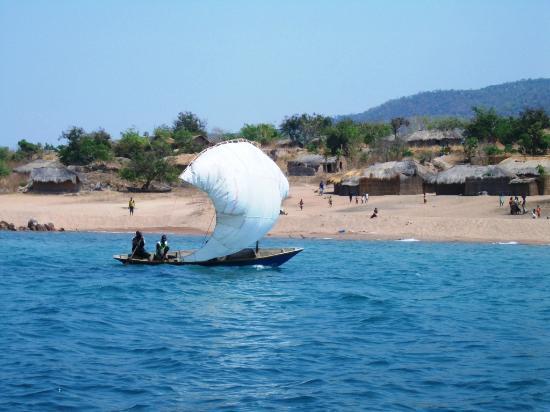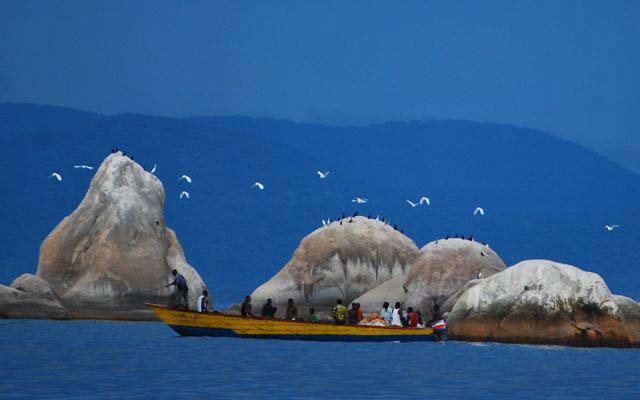 Lake Tanganyika
Lake Tanganyika
Lake Tanganyika is one of the Great Rift Valley Lakes found on the western border of Tanzania, in East Africa. This massive expanse of water is the longest Lake in Africa (720 km long) and is the second deepest Lake in the world (1,470m) – second only to Lake Baikal in Russia. It is said to hold roughly 18% of the world’s available fresh water and is also the world’s second-largest freshwater Lake by volume. There are 26 rivers that flow into Lake Tanganyika and only one (the Lukuga River) that flows out. Only the upper 100m of the Lake is oxygenated.

The Lake’s temperature is typically 24 to 26 degrees Celsius (70 degrees Fahrenheit) all year round. It has an average ph of 8.4. The Lake boasts visibility of up to 20m with massive boulders, spectacular drops offs, and a shell-covered bottom. It is thought to date back 9 to 20 million years and is one of the richest aqueous environments in the world, supporting at least 280 varieties of fish. Most of the 200 or more types of cichlid fish found here are endemic to the Lake. These small, colorful fish are exported for aquariums and fish tanks around the world.
Because of their unique feeding techniques, Tanganyika cichlids prefer different habitats. This means that by going only a few hundred meters, you are able to view totally different species, making your diving and snorkeling trips very exciting. Apart from cichlids, you can also catch a glimpse of otters, speckled eels, catfish, burrowing clams, and freshwater crabs. In the deeper water, you may well spot some of the larger fish – “Kuhe” (Boulengerochromis microlepis) and “Sangala Pamba” (Lates Angustifrons), or even the Lake Tanganyika jellyfish, a nearly transparent, pulsating disc about 2 cm in diameter. Freshwater jellyfish are unusual as most species are found in the ocean. This species is completely harmless to swimmers and does not sting like those found in the sea.

A landlocked Sea
It is essentially a landlocked sea but in years of heavy rain, the lake overflows into the Lukuga River which in turn feeds Congo DR’s Lualaba River. Despite the ferocious surface storms that occur, driving waves up to six meters high (20 feet), no mixing of the lower relict waters occurs. The bottom 1 200 meters of the lake remain ‘dead’ – either too high in hydrogen sulfide or too low in oxygen to support life. This ‘fossil water’ may be as old as 20 million years. By contrast, the oceans, because of currents and upwellings have life forms even as low as 11000 meters (36 080 feet). Lake Tanganyika has a remarkably uniform temperature. The lower regions are only a mere 3° C colder than the surface. The reason for this strange phenomenon has yet to be discovered.

Tropical Fish
Lake Tanganyika boasts over 350 species of fish of which most are endemic. Like Lake Malawi, Lake Tanganyika is extremely old, and the combination of its age and ecological isolation has led to the evolution of unique fish populations. Since new species are being discovered continually in these remarkable lakes, it is difficult to determine which has the highest diversity, but they at least share the distinction of being the top two lakes in the world in terms of biodiversity, whilst Lake Tanganyika has the highest proportion of endemicity, concentrated mainly in the Zambian waters of the lake.
The Lake Tanganyika Biodiversity Project has been set up to ensure that its biological diversity is maintained. The aim of the project is to produce an effective and sustainable system for managing and conserving the biodiversity of Lake Tanganyika. As Lake Tanganyika is a border for four countries Zambia, Burundi, Democratic Republic of Congo- the success of the project will depend on how well these countries work together. The project which began in 1995 comes to an end in the year 2000 and is funded by the Global Environmental Facility through United Nations Development Programme (UNDP).

Species of particular note include the Giant Nile Perch (Lates angustifrons) and Small Nile Perch (Luciolates stappersii) which are important commercial and sports fishing (that is angling) species, Goliath Tiger (Hydrocynus goliath) and the English Fish or Lake Tanganyika yellow-belly (Boulengerochromis microlepis) which are important angling species (the latter being especially prized for its good eating), the Kapenta (Limnothrissa miodon) which is an important source of fish-protein in Zambia, the rare Bichir (Polypterus congicus), and a great variety of endemic Cichlids.

